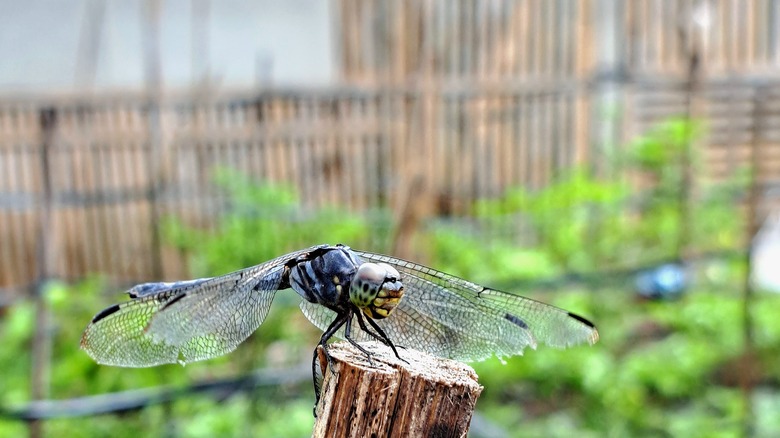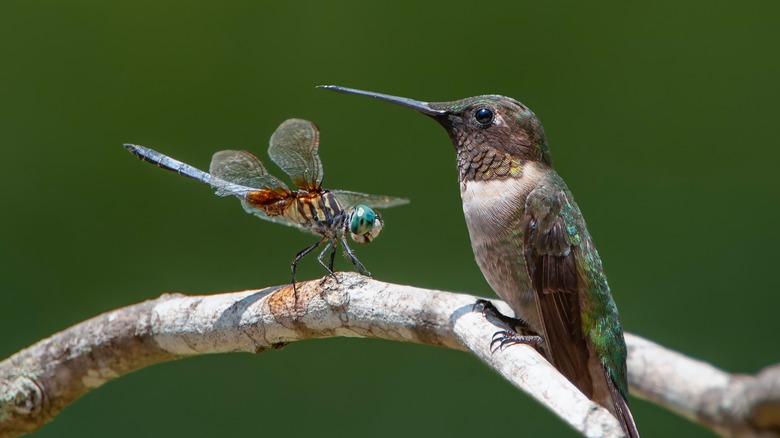Why You Should Keep Large Dragonflies Away From Your Hummingbird Feeders
You've probably already heard that seeing a praying mantis on your hummingbird feeder is cause for concern. They're big, hungry, and opportunistic bugs. In fact, there have been cases of mantises literally hanging on feeders, lying in wait to grab a visiting hummingbird to satiate their appetite. Well, there's another fast and furious insect you might soon have reservations about (at least, where your feeder set up is concerned): dragonflies. These expert predators grab their prey mid-flight, quickly wolfing them down. If the opportunity presents itself, an unsuspecting hummingbird, especially a fledgling or an adult bird on the smaller side, may become the next victim of these entomological jet fighters.
The idea that hummingbird's could become lunch for dragonflies was long thought to be an urban legend, bandied about in birder and home gardener circles though never proven. Many couldn't fathom that dragonflies could feed on hummingbirds because of their assumed size difference. However, while hummingbirds measure 3 to 4 inches on average and weigh in at around 0.1 to 0.2 ounces, the biggest dragonfly species in the U.S., the giant darner dragonfly (Anax walsinghami), grows to an astonishing 5 inches long. Combine this with this winged insect's impressive hunting capabilities, and is it really that far-fetched to think dragonflies might prey on hummingbirds? Maybe not, but just how it happens is still very much up for debate, since few people — scientists or enthusiasts alike — have officially documented the act or captured it on film.
Why, when, and how dragonflies prey on backyard hummers
Recently, birders are adding odonate (dragonfly) watching to their repertoire of wildlife observing hobbies. Perhaps the fact that there are more eyes than ever on this order accounts for the rise in sightings of harrowing hummingbird-dragonfly interactions. There are at least a few documented cases of a common green darner dragonfly (Anax junius) attacking a hummingbird, possibly in an effort to protect themselves. These winged predators are prone to lash out rather than run away when alarmed. Some experts speculate that migrating hummingbirds lack the strength to fend off a determined attacker. What's more, they fly unsteadily when exhausted, and this might attract dragonflies. Dragonhunters (Hagenius brevistylus), a type of clubtail dragonfly, might also battle with hummers when defending territory or may even try to eat them. However, most experts believe it's unlikely that hummingbirds are a dragonfly's preferred meal, especially considering there is far more numerous and easier to catch (read: smaller and less aggressive) insect prey out there.
It's also possible that some people are mixing up robber flies and dragonflies. With their long torsos and helicopter-like wings, they look similar. Generally, robber flies are the the type of fly you'll want to keep in your garden for their pest-control abilities. However, reports of the large insects capturing ruby-throated hummingbirds and hummers exist. Unlike dragonflies, robber flies inject their prey with paralyzing toxins. In these cases, the robber flies are almost certainly trying to eat the hummers.
Protect hummingbirds with these dragonfly prevention methods
It's quite possible that you don't need to do anything to protect your tiny feathered visitors. As stated, though dragonflies have been documented attacking hummingbirds, the reports are few and far between; it likely doesn't happen often. Plus, hummingbirds are pretty fierce. Male hummers, for example, are well-known to vigorously defend their food and territory from intruders.
However, if you're concerned, some simple protective measures might offer peace of mind. First, wait to hang your feeders outside until well after the hummers have arrived from migrating in the spring. They'll have energy to defend themselves, and the dragonfly's preferred prey, bugs, will be more abundant. Additionally, since dragonflies complete their life cycles in freshwater, don't hang feeders near ponds or streams. Likewise, hungry dragons are attracted to pollinator gardens or, more aptly, the pollinating insects such gardens attract. Keep your feeders away from flowering plants. If you notice dragonflies swarming, take your hummingbird feeders down until they dissipate. As a bonus, these measures might also work for other hummingbird predators and pests you don't want anywhere near your feeders.
Whatever you choose to do to address this problem, killing the dragonflies that visit your yard is never the right option. Dragonflies are widely considered beneficial insects, efficiently devouring common garden pests like mosquitoes, gnats, and horseflies. Plus, their very existence is increasingly threatened globally as their preferred habits, wetlands, disappear.

